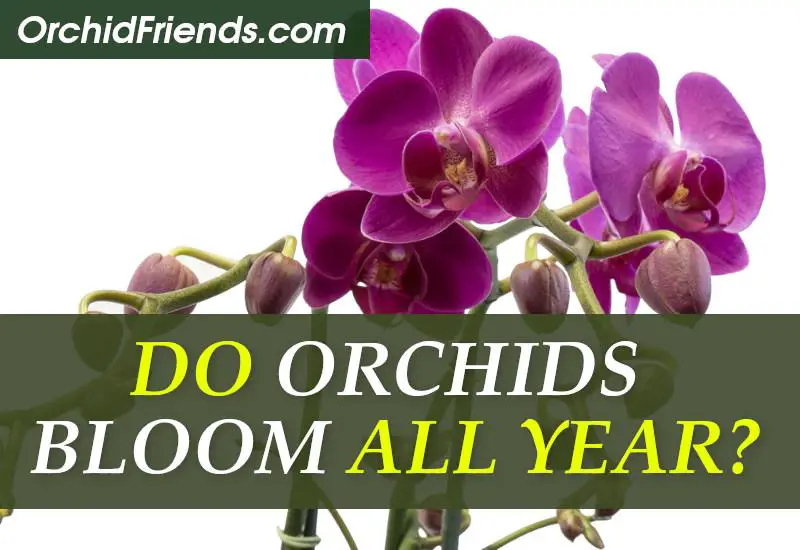
** This post is written and edited by a human being **
During the early spring, most indoor orchids begin blooming. But not all orchids will stay in bloom for the entire season. They will go into dormancy once the summer is over.
Orchids need a steady drop in the nightly temperature in order to bloom. On top of that, orchid blooming is affected by the amount of light, the right amounts of water, and fertilizer. Some growers use a 30-10-10 fertilizer. Orchids should generally be repotted every other year. Read how to repot your orchid.
The length of an orchid’s flowering period is determined by several factors, like the environment. Some tropical orchids will bloom only in the summer, but indoor moth orchids can also bloom during the winter.
Orchids have thick green/silvery roots that are adapted to absorb dissolved nutrients. They need to be watered a few times a week during the hottest season. However, excessive watering can actually kill the roots, so you always need to adjust the watering to the growing environment and changing seasons.
Keeping orchids indoors in the winter helps stimulate the flowering process. The drop in nightly temperatures will trigger blooming, but that doesn’t mean these plants can be exposed to cold drafts. Exposure to cold drafts can shock the orchid, making it drop all its flowers/buds, and it can even kill the plant!
Phalaenopsis orchids cannot be propagated through stem cuttings. Nowadays, they are commonly sold in grocery stores or greenhouses. They can be grown in moss, bark chips, or even terrariums.
Your orchids can last for years if you care for them properly. But as you probably know by now, they are sensitive to watering and require patience.
Orchids will thrive in a location that is bright but not too hot. They will also thrive in a location with a south-facing window. Orchids are prone to some pests, like scales and false spider mites, etc.
Read when or if you should use artificial growth lamps.
Can Orchids Bloom on the Same Stem As the Last Flower
As someone who loves caring for Phalaenopsis orchids, I’m often asked whether these beautiful plants can bloom again on the same stem as their last flowers. It’s a great question, and the answer is yes, but with a few important details to consider.
Phalaenopsis orchids, also known as moth orchids, are unique in that they can sometimes bloom on the same stem after their flowers fall off. After the last flower fades, many orchid owners wonder if they should cut the flower spike or leave it alone. If the stem is still healthy—meaning it hasn’t dried up or turned yellow—you can leave it be. In some cases, you might see new buds appear along the old flower spike, resulting in another round of blooms on the same stem. This can happen if the orchid is well-cared-for and the conditions are right, like having enough light, proper temperature, and moisture.
However, it’s important to understand that not every Phalaenopsis will re-bloom from the same stem. If no new buds appear after the flowers drop, it’s not a failure; it’s just part of the orchid’s natural growth cycle. In that case, you can help encourage new growth by cutting the old stem back to just above a node (the small bump on the stem). This may trigger a new flower spike to emerge from that node, and in a few months, you could see another beautiful round of flowers.
In summary, Phalaenopsis orchids can bloom on the same stem, but it’s not always guaranteed. The key is ensuring your orchid stays healthy with proper care, and if needed, giving the old stem a gentle cut to encourage new growth. With a little patience and attention, you’ll likely be rewarded with beautiful blooms, whether they come from the old spike or a new one!
Tip: Read How to Save Orchid Flowers.



